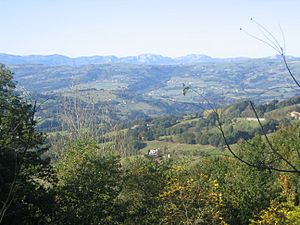Karrantza facts for kids
Quick facts for kids
Karrantza Harana/Valle de Carranza
|
|||
|---|---|---|---|

Karrantza Harana/Valle de Carranza
|
|||
|
|||

Location of Karrantza within Biscay
|
|||
| Country | |||
| Autonomous community | |||
| Province | Biscay | ||
| Comarca | Enkarterri | ||
| Area | |||
| • Total | 137.87 km2 (53.23 sq mi) | ||
| Elevation | 155 m (509 ft) | ||
| Population
(2018)
|
|||
| • Total | 2,715 | ||
| • Density | 19.692/km2 (51.003/sq mi) | ||
| Time zone | UTC+1 (CET) | ||
| • Summer (DST) | UTC+2 (CEST) | ||
| Postal code |
48891
|
||
Karrantza Harana, also known as Valle de Carranza, is a town and municipality in the Biscay province of the Basque Country in Spain. It's the largest municipality in Biscay by area. The town is located in the Enkarterri region.
The famous film director Víctor Erice was born here.
Contents
What's in a Name? The Etymology of Karrantza
The name Carranza first appeared in a document called the Chronicle of Alfonso III. This was back in the 10th century. In this old text, the name was written as Carrantia.
The word Carrantia comes from an old dialect spoken in the Cantabrian region. It means "high rocks." Over time, Carrantia changed into Carranza, which is the Spanish name used today. The Basque name, Karrantza, is an adaptation of Carranza. It follows the rules of Basque spelling. Since 2001, both Karrantza and Carranza are official names for the municipality.
A Glimpse into Karrantza's Past
People have lived in the Karrantza valley for a very long time. The oldest signs of human life here are stone tools. These tools date back to the late Middle Paleolithic period.
Ancient Art and Early Settlers
Karrantza is home to the Venta Laperra sanctuary. This is the oldest sanctuary in the entire Basque Country. It features amazing Paleolithic art. There's also proof of ancient farming and art from hunter-gatherers. These findings come from the Neolithic and Bronze Age.
Roman Connections
Local stories say that Romans once lived in the valley. They were interested in mining a mineral called galena from the Ubal mountains. Archeologists found Roman pottery during digs in some local caves. In 1903, over one hundred Roman coins were discovered. These coins were from the years 238 to 260.
Early Records and Joining Biscay
The first written records about the Karrantza valley are from the 8th century. At that time, King Alfonso I of the Kingdom of Asturias was settling new areas. The valley was mentioned in the Chronicle of Alfonso III about a century later.
The valley of Karrantza became part of the Lord of Biscay in the 12th century. It belongs to the Enkarterri territory. This area joined Biscay in the 13th century.
Karrantza's Population Over Time
The number of people living in Karrantza has changed over the years. Here's a look at the population at different times:
- 1900 - 4,237 people
- 1910 - 4,463 people
- 1920 - 4,506 people
- 1930 - 4,458 people
- 1940 - 4,479 people
- 1950 - 4,687 people
- 1960 - 4,490 people
- 1970 - 3,953 people
- 1981 - 3,392 people
- 1991 - 3,149 people
- 2001 - 2,887 people
- 2004 - 2,884 people
- 2009 - 2,810 people
- 2018 - 2,715 people
Where is Karrantza?
Karrantza is located in the westernmost part of the Enkarterri region. It is the largest municipality in Biscay by area. The town is about 54 kilometers (about 33 miles) from Bilbao, the capital of the province.
Karrantza shares its borders with several places:
- To the north, it borders the autonomous community of Cantabria.
- To the east, it mostly borders Villaverde de Trucios. This is an exclave of Cantabria. It also borders the Basque municipalities of Turtzioz and Artzentales.
- To the south, it borders the province of Burgos.
- To the west, it borders the small municipality of Lanestosa and the Cantabrian community.
Sports in Karrantza
The most important sports club in Karrantza is the Karrantza CD football club. They play in the regional football leagues of the Basque Country.
See also
 In Spanish: Valle de Carranza para niños
In Spanish: Valle de Carranza para niños



